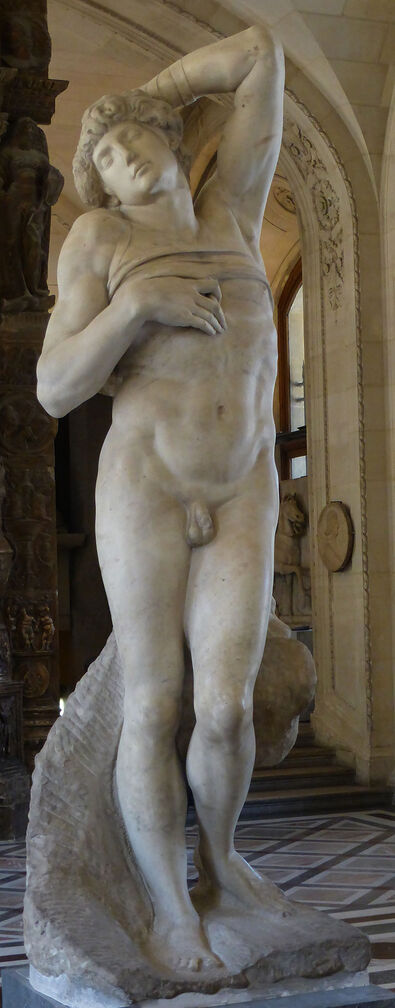|
Michangelo’s Captive I wished to photograph a beautiful man sculpted by Michelangelo, afraid I would forget him if I did not, for he had no story, no name. But I turned away. I had the feeling I should not be watching our guide’s pleasure; he knew nothing about the work’s history but exclaimed over the marble as a singer praises the beloved. His face was a study of amazement—that such a being could exist in the world, his luminous form revealed every day to someone like you or me or him, a tour bus driver posing as a cultural authority, relying on the fact that no one in his group spoke French to conceal that he was making up what this painting or that sculpture in the Louvre was “about.” Never mind that proper names are perfectly recognizable, or that one romance language sounds very much like another. We stood before the Esclave mourant, dying into eternal life. The Captif. And we were captivated by that white vision of slavery. Not by an assault. Not by the historical experience of tribes conquered by the Romans. We were caught up in what Michelangelo knew about the body. About fantasy and bondage. And the man, the model—May he have enjoyed the wine, the bread soaked in olive oil, and the eye of the master, intoxicating as any drug given to calm a victim before sacrifice. May he have loved the hands that adored him, that memorized him, that altered him and memorialized him in marble. One of his arms is held high, bent at the elbow, hand behind his head, and the other caresses his chest in a gesture of exposure and self-love and sensuality so palpable that it is difficult to see that there are carved straps holding his raised arm behind him and that what he pushes upward is not a tunic but leather bindings that might have secured him to a post or pillar. Here, he is tied to nothing but our gaze and the sunlit air. He is so proportioned and positioned, his face so peaceful, his hair in such even waves. He might be half-stretching at the studio window, his body somewhere between dreaming and waking, bone and muscle bearing weight, bound only to the law of beauty, its balance of line, the more curved and the less straight, a natural form that leaves the eye desiring nothing beyond what is there and there and not there. Michelangelo Buonarroti was a perfectionist. Also a man famous for leaving things unfinished. Perhaps beauty is always unfinished. So, this captive, undone. His right foot, toes spread, barely emerges from the stone that bears him, the block the sculptor delivered him from. Dana Sonnenschein Dana Sonnenschein lives in the woods in New England, where she teaches online at Southern Connecticut State University; she’s been documenting the wildflower season on Instagram and making her four cats very happy over the last few months … because they know nothing about the pandemic. Her publications include Bear Country, Natural Forms, No Angels but These, and Corvus. Recent work appears in The Matador Review, The Prachya Review, Algebra of Owls, Permafrost, and Terrain.org’s Dear America anthology.
0 Comments
Your comment will be posted after it is approved.
Leave a Reply. |
The Ekphrastic Review
COOKIES/PRIVACY
This site uses cookies to deliver your best navigation experience this time and next. Continuing here means you consent to cookies. Thank you. Join us on Facebook:
Tickled Pink Contest
April 2024
|




